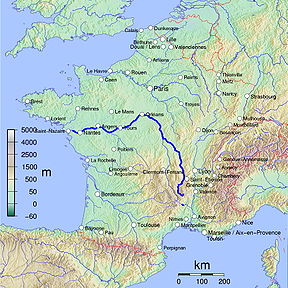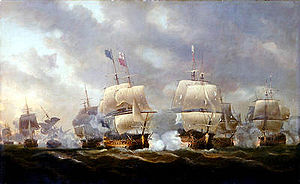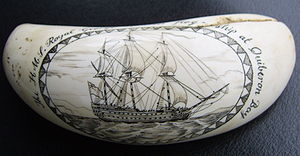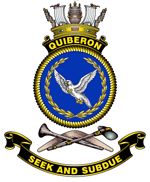|
The Battle of Quiberon Bay November 20, 1759

Map Quiberon Bay
It was during the Seven Years war between England and
France that the
Battle of Quiberon bay was fought on November 20, 1759.
The opposing forces were Admiral Sir Edward Hawke with 23
ships of the
line versus Marshal de Conflans with 21 ships.
At the time it appeared France was preparing to invade
both England and
Scotland, with both troops and their ship transports
massing around the
Loire estuary. The Loire river is the longest in France,
rising in the
Cevennes to debouch into the Bay of Biscay. 
Loire River
At the Battle of Lagos on August 19, 1759, the French
Mediterranean Fleet
had suffered a defeat at the hands of the British Admiral
Edward
Boscawan thus thwarting French plans to invade both
Britain and
Scotland.
The French Fleet bottled up at Brest by the Royal Navy
blockade was
ordered to break out and collect the French transports at
the Gulf of
Morbihan in Southern Brittany.
The weather was gale force and tended to favour the
British, as Admiral
Hawke took his ships southward to try and prevent the
French breaking
out from Brest.
He found the French some 20 miles out to sea, and ordered
a general chase.
de Conflans then sought the santicty of Quiberon Bay.
With such wild weather prevailing the French Commander
reasoned that
Hawke would not follow, and that his 21 ships would be
safe, but he had
not reckoned on the boldness of his advisary.

Battle of Quiberon Bay. Nicholas Pocock 1812.
National Maritime Museum.
Now allow me to let the words of Admiral Sir Edward Hawke
in his report
to Their Lordships at the Admiralty speak for themself.
The Battle of Quiberon Bay Admiral Sir Edward Hawke
The
Royal George, off Penris Point, 24 November 1759.

Royal George engraved on walrus ivory.
In my letter of the 17th by express, I desired you would
acquaint their Lordships with my having received
intelligence of eighteen sail of the line, and three
frigates of the Brest squadron being discovered about
twenty-four leagues to the north-west of Belleisle,
steering to the eastward. All the prisoners, however,
agree that on the day we chased them, their squadron
consisted, according to the accompanying list, of four
ships of eighty, six of seventy-four, three of seventy,
eight of sixty-four, one frigate of thirty-six, one of
thirty-four, and one of sixteen guns, with a small vessel
to look out. They sailed from Brest the 14th instant, the
same day I sailed from Torbay. Concluding that their first
rendezvous would be Quiberon, the instant I received the
intelligence I directed my course thither with a pressed
sail. At first the wind blowing hard at S. b. E. and S.
drove us considerably to the westward. But on the 18th and
19th, though variable, it proved more favourable. In the
meantime having been joined by the Maidstone and Coventry
frigates, I directed their commanders to keep ahead of the
squadron, one on the starboard, and the other on the
larboard bow. At half-past eight o'clock on the morning of
the 20th, Belleisle, by our reckoning, bearing E. b. N.
1/4 N. about thirteen leagues, the Maidstone made the
signal for seeing a fleet. I immediately spread abroad the
signal for the line abreast, in order to draw all the
ships of the squadron up with me. I had before sent the
Magnanime ahead to make the land. At three-quarters past
nine she made the signal for seeing an enemy. Observing,
on my discovering them, that they made off, I threw out
the signal for the seven ships nearest them to chase, and
draw into a line of battle ahead of me, and endeavour to
stop them till the rest of the squadron should come up,
who were also to form as they chased, that no time might
be lost in the pursuit.... Monsieur Conflans kept going
off under such sail as all his squadron could carry, and
at the same time keep together; while we crowded after him
with every sail our ships could bear. At half-past two
p.m. the fire beginning ahead, I made the signal for
engaging. We were then to the south-ward of Belleisle, and
the French Admiral headmost, soon after led round the
Cardinals, while his rear was in action. About four
o'clock the Formidable struck, and a little after, the
Thesee and Superbe were sunk. About five, the Heros
struck, and came to an anchor, but it blowing hard, no
boat could be sent to board her. Night was now come, and
being on a part of the coast, among islands and shoals, of
which we were totally ignorant, without a pilot, as was
the greatest part of the squadron, and blowing hard on a
lee shore, I made the signal to anchor, and come-to in
fifteen-fathom water.... In the night we heard many guns
of distress fired, but, blowing hard, want of knowledge of
the coast, and whether they were fired by a friend or an
enemy, prevented all means of relief.... As soon as it was
broad daylight, in the morning of the 21st, I discovered
seven or eight of the enemy's line-of-battle ships at
anchor between Point Penris and the river Vilaine, on
which I made the signal to weigh in order to work up and
attack them. But it blowed so hard from the N.W. that
instead of daring to cast the squadron loose, I was
obliged to strike topgallant masts. Most of the ships
appeared to be aground at low water.... In attacking a
flying enemy, it was impossible in the space of a short
winter's day that all our ships should be able to get into
action, or all those of the enemy brought to it. The
commanders and companies of such as did come up with the
rear of the French on the 20th behaved with the greatest
intrepidity, and gave the strongest proofs of a true
British spirit. In the same manner I am satisfied would
those have acquitted themselves whose bad-going ships, or
the distance they were at in the morning, prevented from
getting up. Our loss by the enemy is not considerable. For
in the ships which are now with me, I find only one
lieutenant and fifty seamen and marines killed, and about
two hundred and twenty wounded. When I consider the season of the year, the hard gales on the day of action, a flying
enemy, the shortness of the day, and the coast they were
on, I can boldly affirm that all that could possibly be
done has been done. As to the loss we have sustained, let
it be placed to the account of the necessity I was under
of runing all risks to break this strong force of the
enemy. Had we had but two hours more daylight, the whole
had been totally destroyed or taken; for we were almost up
with their van when night overtook us....

Battle of Quiberon Bay, the Day after.
Richard Wright, 1760.
This battle removed the threat of the French Fleet and any
possible invasion of Britain.
IT WAS A GREAT NAVAL VICTORY.
To quote Alfred Thayer Mahan ( The Influence Of Sea Power
on History )
"The Battle of the 20th of November 1759 was the Trafalgar
of the Seven Years War,
and the English Fleets were now free to act against the
colonies of France, and later of
Spain, on a grander scale than ever before.
For instance, the French could not follow up their victory
at the Battle of Sainte-Foy
( Battle of Quebec ) in 1760 for want of reinforcements
and supplies from France.
So the Battle of Quiberon Bay may be regarded as the
Battle that determined the fate of New France and Canada.
Post the Battle of Quiberon Bay, HMAS Quiberon was so
named to remember that
famous naval victory in 1759. 
HMAS Quiberon

Ship Crest
|
|
|







